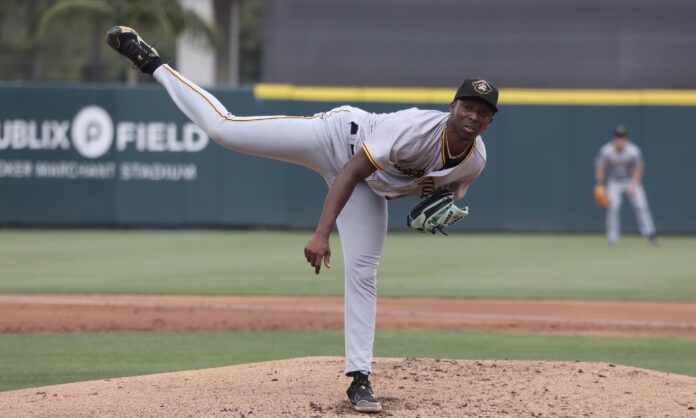It’s been a very good couple of weeks for Pittsburgh Pirates’ prospect JP Massey. After earning Florida State League Pitcher of the Month in May, the righty got promoted to High-A Greensboro, where he’s made his first couple of starts already.
On Monday another honor reached the former seventh round pick of Minnesota: He was named to the Future’s Game along with fellow prospect Endy Rodriguez.
For a player that was somewhat of an afterthought when drafted, that’s a long way to come in less than a year.
Massey put up really strong strikeout numbers in college, but was plagued by walks, which is why there wasn’t much thought of him when he was taken.
He was the talk of camp, with him being a player that many thought could have some success this upcoming season.
The biggest reason behind Massey’s success so far has been his breaking pitches, along with the strides he’s made with his control.
Along with his fastballs, Massey has been working in a changeup, slider, and curveball. The two breaking pitches absolutely dominated Single-A hitters, generating some unreal whiff rates while there.
| Slider | Curveball | |
| Opponents AVG | .181 | .078 |
| Opponents SLG | .318 | .105 |
| Strikeout% | 56.2% | 48.8% |
| Whiff% | 50% | 59.38% |
| CSW% | 35.45% | 43.84% |
Hitters stood little chance against either of his breaking pitches, especially the curveball. During his time in Bradenton, Massey allowed just three hits off his curve, and only one went for extra-bases.
While the slider was put in play more, and he allowed a pair of home runs with it, he also posted a strikeout rate of nearly 60% with the pitch.
This is a video from perhaps Massey’s best start during his time in Bradenton, on May 13 where he struck out nine batters across five innings.
He threw a total of 38 slider and curveballs that day, finishing with a whiff rate of 76.9% (10-of-13) while a Called Strike plus Whiff rate (CSW%) of 50%. That means half of the breaking pitches Massey threw that day were either a whiff, or a called strike.
When the Pirates drafted Massey, he was among a very large group of college pitchers added to the system. At first glance it looked like they were just trying to add depth to the system, especially after using a good amount of their bonus to get Termarr Johnson, Thomas Harrington and Michael Kennedy signed.
Now, they’ve turned one of them into a pitcher who will be at the Future’s Game, less than a year after drafting him.
The biggest reason behind it has been improved command, and a pair of dominating breaking pitches. He’ll have to show that the stuff carries to a more advanced level, and the Future’s Game is a good chance to really get an idea of where he’s at. Regardless, the breaking pitches allowed him to absolutely dominate Single-A.



